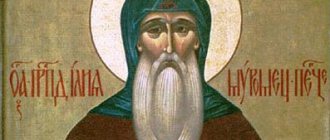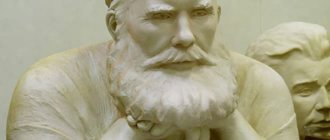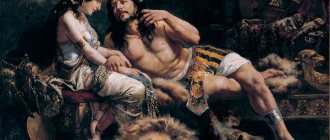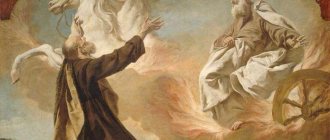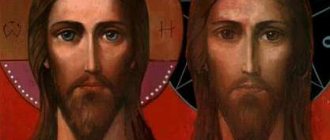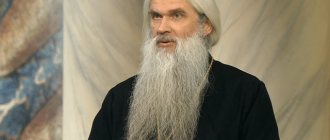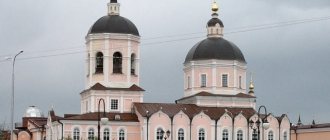This man was once paralyzed for 30 years and did not move at all. Passers-by miraculously healed him, he became a famous warrior, and now people come to his relics to be healed.
Everyone knows the painting of the three heroes, which depicts Dobrynya Nikitich, Alyosha Popovich and Ilya Muromets.
Painting by Vasnetsov, which depicts: in the middle on a black horse - Ilya Muromets, on the left on a white horse - Dobrynya Nikitich, on the right on a brown horse - Alyosha Popovich
The prototype of Ilya Muromets, an epic character, is considered to be the Venerable Ilya Muromets of Pechersk. Let's look at who he was and how he lived in more detail.
Ilya Muromets helps in any life circumstances. Memorial Day of Elijah - January 1
Now his relics rest in the Anthony Caves
Where are the relics of the saint kept?
Many sources indicate that the relics of Ilya Muromets rest in the Anthony Caves in the Kiev Pechersk Lavra.
Somewhere in the 18th century, one pilgrim Leonty left the following note:
Leonty
pilgrim
“The sight of the brave warrior Elijah of Murom in incorruption under the cover of gold; tall - like today's large people; his left hand is pierced with a spear, the entire wound is visible (visible), and his right hand is depicted with the sign of the cross.”
In 1988, an examination of the relics of Ilya Muromets was carried out. After examining the relics, it was determined that Ilya died at the age of 40–45 years, his height was about 177 centimeters. Some defects in the spine were revealed, which indicates that the person suffered paralysis of the limbs in his youth. The cause of death was also established - a large wound in the heart area.
1st of January
Memorial Day of Ilya Pechersky - prototype of Ilya Muromets
In 1643, Ilya Pechersky was canonized. The saint's memorial day is January 1.
Local veneration of St. Elijah began around the end of the 17th century. Then, when the celebration of the Council of the Reverend Fathers of the Near Caves was established.
The remains of Ilya Muromets, namely the middle finger of the left hand, are currently in the Spaso-Preobrazhensky Monastery in the city of Murom. In the photo below you can see the relics of the saint.
The fingers of the right hand are folded specifically for prayer, as is customary in the Orthodox Church: the first three fingers are together, and the last two are bent to the palm
You can venerate a piece of his relics at any time.
It is often said that Ilya Muromets is a miracle worker.
From the holy relics of the monk, people are healed from many diseases, especially those with spinal diseases and those whose legs are paralyzed.
Even after his death, Ilya the Pechersk miracle worker helps people.
Venerable Ilya of Pechersk Muromets
Share
The memory of saints from different centuries is preserved by many legends, ancient traditions, and folk epics.
The relics of St. Elijah of Pechersk or Ilya of Muromets are kept in the Anthony Caves of the Kiev-Pechersk Lavra.
Folk legend identifies the saint with that same fair and kind hero Ilya Muromets from Russian epics.
EPIC:
From either the city of Murom, from that village and Karacharova, a distant, portly, kind fellow was leaving. He stood at matins in Murom, and he wanted to be in time for dinner in the capital Kyiv-grad...
Scientists suggest that the Monk Ilya Pechersky, nicknamed Chobotok, was born in the 12th century in the village of Karacharovo near Murom in the Vladimir region in the family of the peasant Ivan Timofeevich Chobotov and his wife Euphrosyne.
Since childhood, Ilya was paralyzed, and then at the age of 30 he was miraculously healed by three prophetic elders - kaliki wanderers, as beggar wanderers were called in Rus'. The elders predicted to Ilya that “death in battle is not written for him.” Having taken his parents' blessing, Ilya left his native village and went to serve the Kyiv prince.
EPIC:
Oh, you goy, dear, dear father! Give me your blessing, I will go to the glorious capital city of Kiev - to pray to the miracle workers of Kyiv, to pledge myself to Prince Vladimir, to serve him with faith and truth, to stand up for the Christian faith”...
In some epics, Ilya Muromets is in military service with Prince Vladimir, the Baptist of Rus', who lived long before the 12th century; in other epics, the image of the Grand Duke Vladimir Monomakh is discernible
The epic hero Ilya Muromets fights not only with the fictional Nightingale the Robber, but also with the “filthy idol”, as the Pechenegs were called in Rus', and with the Khazars, and with another enemy “great strongwoman”.
EPIC:
Yes, he drove up to the glorious city of Chernigov, Is it near the city of Chernigov that black and black forces are overtaken, And it is black and black, like a black crow. So reluctantly no one walks here, No one rides here on a good horse, The black raven bird does not fly over, Let the gray beast not prowl. And he rode up to a great powerhouse, He began to trample this great powerhouse with his horse and began to stab him with a spear, And he beat this entire great power...
Ilya Muromets became famous for his numerous military exploits, and also for the fact that he used his unprecedented strength only to fight the enemies of the Fatherland. The Russian hero does not brag about his exploits, and never takes up arms for the sake of a princely reward.
In the popular consciousness, the epic Ilya Muromets is a true Christian who is ready to lay down his life “for his friends” and for the sake of protecting the Fatherland. In love for the Church, the peasant son from the village of Karacharovo is equal to the Grand Duke of Kyiv.
EPIC:
He came to the glorious capital city of Kyiv and to the glorious prince in the wide courtyard. And Vladimir the Prince, he left the Church of God, He came to the white-stone chamber, He sat down to his dining room in the little room, He sat down to eat and drink and eat bread, Eat bread and have lunch. And here the old Cossack and Ilya Muromets stood up his horse in the middle of the yard, He himself goes into the white-stone chambers. He walked into the dining room in the little room, he swung the door on his heel*. He placed the cross in a written way, made bows in a learned way, bowed low to all three, four to the sides, to Prince Vladimir himself in particular, and to all his princes he kneeled.
According to legend, in one of the battles with the Polovtsians, Ilya Muromets received an incurable wound in the chest and soon after that he took monastic vows at the Kiev-Pechersk Dormition Monastery. He died approximately at the age of 45.
In 1988, a special commission conducted an examination of the incorruptible relics of St. Elijah of Pechersk, determining that in his youth he, in fact, suffered from paralysis of the limbs and died from a wound in the chest.
The relics of St. Elijah of Pechersk Muromets are also spoken of in one of the folk epics:
EPIC:
...Ilya Muromets Hired cunning carpenters. He built the cathedral church of St. Nicholas of Mozhaisk in Slavny in the city of Kyiv. He himself drove into the deep caves, and then Ilya died. To this day his relics are incorrupt!”
Olga Klyukina was with you. See you again in the author’s program: “Prototypes: saints in literature.”
Those who serve in the army often turn to the icon of Ilya Muromets
The icon of Ilya Muromets amazes with its heroic physique and huge hands. Ilya looks rather stern.
Saint Ilya Muromets is the patron saint of the Russian Strategic Missile Forces and the Russian Border Guard Service
What do they pray to the icon of Ilya Muromets for? They pray to the icon:
- in difficult life situations;
- about the healing of sick children, as well as children with cerebral palsy;
- about the protection of the weak who need help and support;
- those who serve in the army to withstand all the tests.
It is believed that those who go by the name Elijah should have an icon, and especially if the Monk Elijah is a patron.
Memory
The Monk Elijah of Muromets is numbered among the Cathedral of Murom Saints.
Russian people still honor the memory of the holy hero. In his supposed homeland, on January 1, 1993, in the Church of Saints Guria, Samon and Aviv, an icon of Saint Elijah with a particle of his relics was solemnly installed. In 1994, a chapel in the name of the saint was founded at the city cemetery, which was consecrated four years later. The Monk Elijah of Muromets is numbered among the Cathedral of Murom Saints.
Military personnel of the Strategic Missile Forces and the Russian Border Guard Service, as well as special forces units, consider the holy hero their heavenly patron.
In 1998, on the territory of the Main Headquarters of the Missile Forces in the Moscow region, a temple was built and consecrated in the name of St. Elijah of Muromets. In the altar of the temple there is an icon of the saint with a particle of relics from the Kiev Pechersk Lavra.
In Kosovo (Serbia), after the Balkan War, for almost four years (from July 1999 to June 2003), a field temple of St. Elijah of Muromets was deployed, which was then taken to Chechnya, where it was located in the Vvedensky district, in the base camp of the Airborne Forces. troops until November 2004. In the field conditions of Kosovo and Chechnya, a large number of soldiers, including those with the name Elijah, received holy baptism in this church in memory of the saint.
The monument to Ilya of Muromets of Pechersk was erected in Rubtsovsk in 2021.
The relics of the saint testify to his military biography
He is the main character not only of our epics, but also of German epic poems of the 13th century, based on earlier legends. In them he is represented as a powerful knight, the princely family Ilya the Russian. The relics of the monk no less clearly testify to his vivid military biography - in addition to a deep round wound on his left arm, one can see the same significant damage in the left chest area. It seems that the hero covered his chest with his hand, and with a blow from a spear it was nailed to his heart. After a completely successful military career and, apparently, as a result of a serious injury, Elijah decides to end his days as a monk and takes monastic vows at the Theodosius Monastery, now the Kiev Pechersk Lavra.
It should be noted that this is a completely traditional step for an Orthodox warrior - to exchange the iron sword for the spiritual sword and spend his days fighting not for earthly blessings, but for heavenly ones. St. Elijah is neither the first nor the last warrior to do this. In this regard, among our compatriots we can recall the great commander Rev. Alexander Nevsky, as well as professional warriors Peresvet and Oslyabyu, who passed obedience under the supervision of Rev. Sergius of Radonezh and those who died heroically on the Kulikovo Field.
On patrol
Prayer
You can especially pray to the Venerable Elijah of Muromets
Prayer to the holy Venerable Elijah of Muromets for healing:
O holy reverend Father Elijah! Holy intercessor of Rus', mighty warrior, a spiritual and physical warrior who appeared to her, who faithfully served in his life for the good of the Russian people and the glorification of the Christian God, and after his repose did not leave his intercession for us, ask, holy, from the All-Merciful Lord for the Tsar of our Fatherland, peace and prosperity, the well-being of the church, deliverance for Orthodox people from the wicked, victory for Russian soldiers in battles and victory against enemies plotting evil for the Church and the Orthodox Fatherland, intercede for us all, and we also ask you, Holy One of God, to grant us reason from God, yes let us know our sins, and spiritual strength, let us repent of our sins, and bodily strength, so that we may be able to correct our lives and revive Holy Rus', and pass from it into the Kingdom of Heaven, and there, with you and all the saints, we will be honored to continually praise the glorified God in the Trinity Father and Son and Holy Spirit forever and ever. Amen.
In front of the icon of Ilya the Wonderworker of Murom, they pray for the healing of children, especially those who are immobile and those with cerebral palsy; about help in difficult life situations, about protection, as he protected the weak. Those who serve in the army turn to him for support in order to perform their service flawlessly.
Curse and miraculous healing
The people passed this story from mouth to mouth.
As if the grandfather of Ilya Muromets was a pagan and, not recognizing Christianity, once cut the icon. Since then, a curse has fallen on his family - all boys will be born crippled. Ten years later, Ilya was born, and it seemed that the curse had been fulfilled: the boy had not been able to walk since childhood. All attempts to cure him were unsuccessful. But Ilya did not give up, persistently trained his arms, developed his muscles, becoming stronger, but, alas, he still could not walk. The years passed, and, probably, more than once it seemed to him that he needed to come to terms with his fate: he would forever remain a cripple.
But when Ilya turned 33, something inexplicable happened. The day came that dramatically and forever changed his life. The elders, the kaliki passers-by (beggar wanderers), entered the house and asked the boy to give him some water. He explained that he could not walk. But the guests persistently repeated the request, which sounded like an order. And Ilya, suddenly feeling unprecedented strength, stood on his feet for the first time...
Ilya got back on his feet after 33 years of immobility. And scientists who conducted research on the relics confirm that the bone tissue of this person was miraculously restored. Moreover, according to their conclusion, after thirty years he led an active lifestyle, which is fully consistent with the epics.
Brief life of the saint
The name of this saint of God is known to all believers. Very little reliable information about the life of this saint has survived to this day.
He came from a simple peasant family. In childhood and adolescence he suffered from paralysis, but was miraculously healed. Before his tonsure, he was a member of the princely squad and became famous for his military exploits and unprecedented strength. Resting in the Anthony Caves are the relics of St. Elias show that for his time he really had a very impressive size and was a head taller than a man of average height.
Epic hero
Attempts to de-Christianize the image of St. Ilia Muromets
In Soviet times, great efforts were made to de-Christianize the image of St. Ilya Muromets with the aim of turning him into “the embodiment of the people’s ideal of a hero-warrior.”
So, for example, a well-known episode of the epic was subjected to a characteristic cleansing, when “passing Kaliki” came to the motionless Ilya of Muromets, who ultimately healed Ilya. Who they are is omitted in all Soviet publications. In the pre-revolutionary edition of the epic, “Kaliki” is Christ with two apostles.
Reverend Elijah Muromets - legend and reality
When St. Petersburg was tonsured Or me?
The paucity of information about the life of St. Elijah in the Kiev-Pechersk Patericon indirectly indicates that the holy warrior did not spend much time in monastic exploits.
This gives reason to assume that Elijah Muromets was tonsured during the time of the abbess of St. Polycarp of Kiev-Pechersk (1164-1182), and under the leadership of this same great ascetic the spiritual growth of the new warrior of Christ took place.
It is known that Rev. Polycarp enjoyed great respect from Grand Duke Rostislav Mstislavovich. During Great Lent, the prince used to invite the venerable abbot with the twelve brethren of the Theodosian monastery every Sunday for soul-searching conversations.
It is quite possible that one of the participants in these conversations was the former glorious warrior Rev. Or me.
